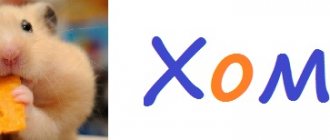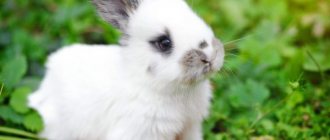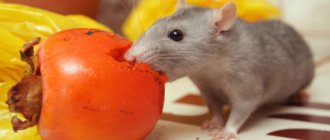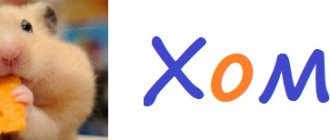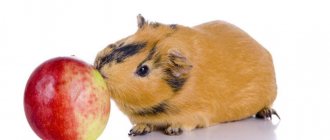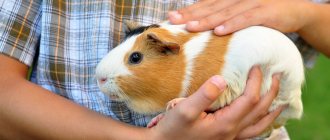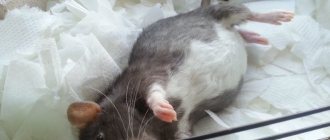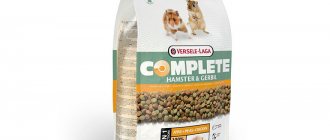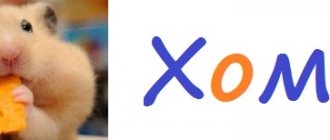A caring owner is always concerned about improving the living conditions of his pet. An important aspect of caring for a hamster is feeding. Inexperienced rodent owners are interested in how many times a day to feed a hamster so that the pet feels cheerful, stays healthy and cheerful.
Proper, nutritious nutrition is an important element that contributes to the longevity of an animal. Diet is as important as the foods that make up the animal’s diet. Read more about the list of prohibited and permitted products to avoid health problems for your pet.
Hamsters are most active at night. During the day, rodents prefer to sleep or rest. When thinking about how often to feed a hamster, you should take into account the rhythm of the animal’s life.
How many times a day should you feed your hamster?
Feeding frequency
- once - late in the evening;
- twice - in the evening and early in the morning.
If the owner determines for himself a comfortable time for feeding the animal and sticks to it, then the rodent will always wait for the food it is supposed to eat at exactly this time. And such stability in the timing of food supply has a positive effect on the animal’s digestive processes.
Also, due to their accelerated metabolism, these pets can wake up several times during the day to have a snack..
- Do not overfeed the animal - feeding twice a day is most optimal.
- Do not disturb the rodent's sleep by constantly feeding it throughout the day.
- Regularly audit inventory, removing spoiled products.
Amount of food
- what is his physical activity;
- what age is the animal, since young animals need more food ;
- what is his physiological state - a painful condition, pregnancy or lactation;
- what are the environmental conditions - room temperature.
The breeder does not have to resort to such precise mathematical calculations. It is enough to observe the animal for several days to determine how much food it needs. It is important not to overdo it with the amount of food, otherwise the hamster will quickly gain weight . This will have an impact on his health and life expectancy.
What to give for grinding teeth
Hamsters have teeth that grow throughout their lives, so they need to grind them down all the time. In their natural habitat, they independently find food that provides this opportunity. But being a pet, hamsters become dependent on humans. Therefore, the owner is obliged to take care of the presence of an animal in the cage:
- Branches of deciduous trees . Djungarian hamsters chew them with pleasure, grinding down their teeth. The branches must be thoroughly washed, then boiled for about an hour, and then dried.
- Hard biscuits for dogs . It is given once a week.
- Mineral stone.
It is strictly forbidden to give branches of coniferous trees. They contain resin, which negatively affects the functioning of internal organs.
If the rodent does not grind down its teeth, they will begin to grow quickly and over time can damage the roof of the mouth.
What does the Chilean rodent Degu eat?
Like all rodents, the degu's diet includes:
Degus are exclusively herbivores. It is best to use ready-made food for degu from trusted manufacturers (Versele-laga, Beaphar, Vitakraft), in which the optimal composition has already been selected. Chinchilla food is also suitable for feeding degus.
These rodents have the same habitat and a very similar diet. Degus should be offered hay every day as a source of fiber.
Other products
It is important to include meat in your diet as the main source of protein. The easiest to digest are lean and dietary cuts of beef, chicken and turkey. Occasionally, you can offer hard-boiled chicken and quail eggs. In the wild, dwarfs feed on insects, so in many pet stores you can buy live earthworms or mealyworms, as well as dried “delicacies”.
Another important product in a hamster’s diet are nuts:
- peanut;
- walnuts;
- cashew nuts;
- hazelnut;
- cedar.
It is prohibited to offer coconut, almonds, Brazil nuts, chestnuts, acorns, cherry and apricot pits.
The seeds produce dried sunflower, pumpkin, squash, watermelon and melon. Flaxseed and sesame seeds can be used as anthelmintic.
Many owners can give their pets flour and baked goods as treats, but this issue should be approached carefully:
- fresh loaf and rye bread are strictly prohibited, but the Djungarian will like crackers;
- cookies, pancakes, pancakes and other sweet pastries are not given due to the high sugar and fat content;
- whole grain bread, you can give bran.
Nutrition for elderly and sick hamsters
- Food should be predominantly chopped and grated. also give porridge with water or pureed vegetables without salt and sugar with added vitamins.
- To prevent intestinal disorders, your pet must be given grain food.
The simplest solution is to purchase a ready-made feed mixture. It is sold at any pet store and is relatively inexpensive. It has a pretty good balance of cereals and grains, which will provide the hamster with almost all the necessary elements.
Special cases
Weak, elderly animals
Sick and elderly hamsters should receive similar diets.
For weakened animals, grain feed, baby purees and cereals, ground to a mushy state, are suitable. It is convenient to hide medicine in such food.
Young hamsters
Young hamsters need more food, since their energy is spent not only on active games, but also on body growth. Baby food is perfect for newborn hamsters: fruit, meat or vegetable purees, dairy-free porridge. You will have to feed the baby with a pipette.
Nutrition of Djungarian hamsters
- The basis of the diet of this rodent, like others, is dry food. It is recommended to purchase several different ready-made mixtures at a pet store to balance the supply of all necessary minerals and vitamins.
- Preference should be given to cereals such as buckwheat (raw and cooked), wheat (especially sprouted), oats or oat flakes, barley, pearl barley, lentils, peas, chickpeas. Minimize rice and millet in your diet.
- Raw or oven-dried sunflower seeds without salt.
- You can give milk or cheese to animals, but not more than once a week, and choose high-quality products with a minimum fat content.
- Food rich in protein is also necessary for Djungarians, and the meat should be of a lean variety (beef, chicken) . Meat and offal should be boiled without salt and spices. You can also give your pet 1/3-1/2 of a boiled egg.
- It is better to exclude fresh bread, but a small cracker once a week is allowed.
- to pamper your hamster with nuts, berries, fruits (exclude exotic ones and remove the seeds) and dried fruits , but do not overfeed them in small quantities, since a large amount of sugar in fruits can cause diabetes.
- Vegetables should also be present in the animal’s diet - cucumbers, radishes, bell peppers, cabbage, carrots, zucchini and others. It is also recommended to give various greens, such as parsley, dill, lettuce or spinach.
Djungarian hamsters will only need two main meals - in the evening and early in the morning. At the same time, food must be present in the cage around the clock - it is necessary for daytime snacks.
Are you wondering what to feed your Syrian hamster at home? In fact, the choice is quite large. The diet should be as balanced as possible, so try to include a wide variety of foods. Let's list the main ones.
Cereals
- oats,
- wheat,
- millet,
- sunflower,
- buckwheat,
- sesame,
- alfalfa.
Some experts also believe that it is beneficial for rodents to feast on melon, pumpkin and watermelon seeds. So, you can use them when preparing the feed mixture so that it is as balanced and varied as possible.
Free-living hamsters also regularly supplement their diet with grass, both fresh and dry. Hay not only improves their digestion, but also allows them to grind down their incisors. This is very important - rodents' teeth grow constantly, and if they do not wear down, then as a result your pet will lose the ability to eat normally - you will have to contact a veterinarian for help.
- clover,
- burdock,
- plantain,
- knotweed,
- whine,
- wheatgrass,
- salad,
- parsley.
By the way, speaking of hay, we can recommend keeping on hand a number of thin branches of fruit trees - cherry, pear or apple trees. Hamsters love to chew on them and are also great at grinding down overgrown teeth on them.
Fruits and vegetables
However, the choice should be taken very seriously.
Most of all, rodents love the following vegetables and fruits:
Be careful with pear - it causes stomach upset in some hamsters. So give it a little and watch your body’s reaction.
Along with the purchase of a pet, you must purchase all the equipment for keeping it: a spacious enclosure, toys, a house, a sand bath and feeders. It is recommended to buy a house and toys made of wood, as the squirrel will taste everything and constantly chew on it.
The cage should always be clean. By nature, degus are very clean creatures. They don't tolerate chaos. If the owner forgot to change the bedding or did not tidy up the cage, the pet will throw all irritants out of the cage.
Based on this, you can understand which food is optimal for degus. The exotic nature of these animals lies in the fact that their usual habitat is forests and rocks, deserts and marshy areas of South American countries. They can be found in Chile and Peru, in Brazil. They are also found in some regions of Bolivia.
If you want a charming perpetual motion machine to live at home, the movement of which is difficult to track (even if you do it very diligently), then it is quite possible that this animal can become a good friend. But for those who expect a calm dormouse creature to live with them, it is better to look for another option.
Make sure that all the necessary elements are inside the cells. These are houses and burrows; old clay pots can be used as the latter. These are very active animals. So that they have somewhere to put their energy, shelves are installed in the cages at different levels. They are attached very carefully so that the animal does not get hurt during play.
Be sure to install several bowls for food, as well as a drinking bowl. Bedding is a must. To do this, lay white paper on the bottom, and on it a layer of sawdust or pressed corn cobs. Don't forget about a running wheel, a teeth grinding stone and a sand bath for bathing.
At one time, a female hamster can give birth to 1–11 babies, depending on individual characteristics. The more hamsters there are, the smaller their weight and size will be. An animal can destroy a child who was born with defects or became ill. If the female’s first birth took place at too early an age, when the maternal instinct has not yet developed, the cubs may also face a deplorable fate.
Special ready-made feeds
Since hamsters' nutrition should consist of 80-90% dry food , it is convenient for owners to use ready-made mixtures that are fully balanced and recommended by veterinarians.
Fluffies eat little - approximately 1 tablespoon of food per day , so it is better not to skimp on ready-made food and purchase packages of proven well-known brands. Many food boxes contain not only grains and seeds, but also dried fruits, nuts, tiny sea animals, and mealworms.
It often happens that Djungarian hamsters do not immediately appreciate the prepared food offered. Therefore, the owner needs to be patient and go through several types of brands.
When can you be separated from your mother?
The living conditions should be the same as for adult hamsters: a cage with feeders, drinkers, a house, etc. After 2 months, each hamster will have to be provided with a separate cage, otherwise “wars” for territory will begin.
At the age of one and a half years, and in some cases earlier, your squirrel will become sexually mature. The cycle of females can be from 17 to 25 days; mating occurs during the estrus period. The female degu bears offspring for about three months, after which from 3 to 10 babies are born. Degu squirrels are fully formed, covered with hair and practically independent.
However, in the first weeks of life they need mother's milk, after which the babies begin to introduce themselves to adult food.
How does the metabolism of domestic rodents work?
Small animals have a high metabolic rate, so they need to constantly chew something. During the day, an adult dwarf eats up to 70% of its own weight.
For this reason, they often suffer from diseases such as diabetes and obesity, especially given their sedentary lifestyle compared to their wild relatives.
An important point is that you cannot feed your hamster all the time or add food just for fun, just because he often stands on his hind legs and shows a desire to eat something.
Fluffy will eat everything, but it is very harmful. Sitting in a confined space and constantly eating high-calorie foods, the hamster will quickly gain excess weight and a bunch of health problems.
Animals should definitely be allowed out for walks, played with, and a running wheel should be placed in the cage so that the kids do not gain excess weight. Fluffies should be fed in the morning and evening.


